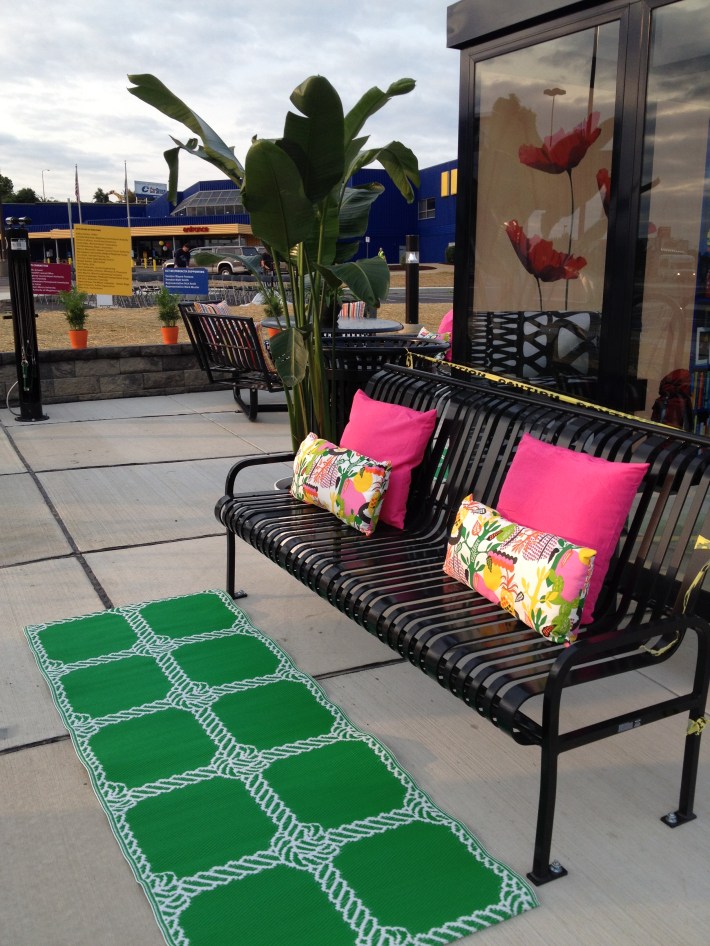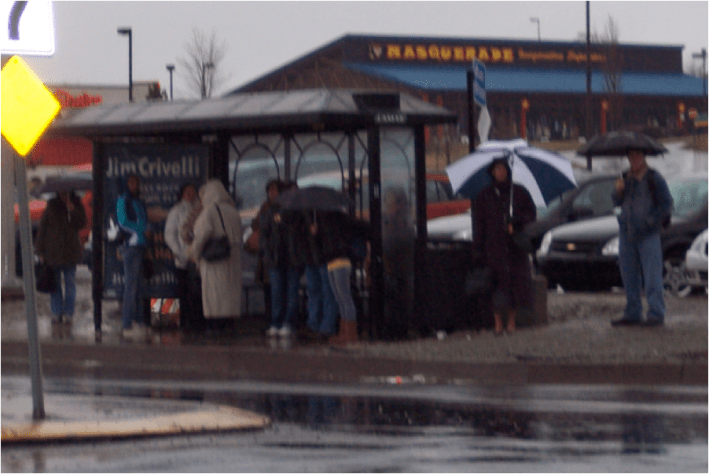
This post is part of a series featuring stories and research that will be presented at the Pro-Walk/Pro-Bike/Pro-Place conference September 8-11 in Pittsburgh.
Last week, Pittsburgh got its first suburban bus stop makeover. And the results were beautiful.
The new IKEA "super-stop" lies in a shopping center along an interstate highway, surrounded by surface parking, between a TGI Fridays and an Office Max. It has a Walk Score of 37: "car-dependent."
This is what the IKEA bus stop used to look like:
But then the Airport Corridor Transportation Association set out to rethink the stop. “We wanted to make the stop inviting enough that people who weren’t riding a bus would still want to come and use the bus stop,” said Lynn Manion of ACTA. They wanted tables and benches, shelter from the elements, and a big enough setback from the curb to make people feel that they weren’t right in the middle of the roadway.
ACTA and its partner, the architecture firm Maynes Associates, realized that in order to encourage ridership, they’d have to change perceptions about the bus stop. They needed to focus on placemaking in order to make that bus stop more appealing -- and to make riders feel less isolated.
For the opening, IKEA put out colorful rugs and pillows to decorate the stop. Those won’t stay, though there will be a permanent plastic film applied to the backs of the bus shelter with images of IKEA furnishings, "so when riders sit on a shelter’s bench it will look like they’re in a living room." It won’t feel like that to the riders so much as look convincingly comfortable to passers-by. And that just might be the most important thing.
ACTA started the project by conducting surveys at all 40 suburban bus stops in the area, determining the factors that made waiting at a bus stop unpleasant for riders. While they had expected riders’ primary safety concern to be about crime, survey participants overwhelmingly cited fast-moving traffic as their main worry. So ACTA pulled the shelter back 10 feet from the curb edge -- thanks to IKEA’s donation of the right of way -- and added bollards to form a "decorative and physical protective barricade" but not "a solid line that traps anybody," as architect Paula Maynes puts it.
The bollards put them at odds with PennDOT, though, which insists on “areas of clearance” with minimal obstructions near intersections in case a driver loses control of a vehicle. (Better just to hit a person waiting for the bus, I guess.) “It raised this fascinating debate about who do the streets and the public right of way belong to,” said Maynes.
The bollards made it into the final product, but some important features were cut. ACTA and Maynes Associates weren’t able to install sidewalks to allow for better pedestrian access between the shopping center and the bus stop, which they had hoped to achieve as part of this project. “I had to fight with the engineer who was designing the project who didn’t see things the way I did in terms of what was important,” Manion said. "There’s a lot of education to be done."
In the end, IKEA made about $1 million worth of improvements to the roadway and the parking lot, making one intersection four-way and installing a traffic signal with a high-visibility crosswalk and beg buttons.
Though crime wasn’t a major concern of the riders whom Maynes Associates surveyed, the architects realized the "fishbowl effect" that the old lighting created was unsettling, especially for women, where the parking lot and the roads weren’t lit but the bus shelter was. "Everything around you is dark; you can’t see out in the darkness but just the people in the shelter are lit up," Maynes said. "They can see you but you can’t see them."
Better lighting also helps the bus drivers and other motorists.
Manion says that when she was working in the city’s planning department years ago, the conventional thinking was, “They build suburbs like that, let ‘em live in it.” She’s past that now. She’d rather rebuild the suburbs as a place where people can walk and ride transit as they go about the business of their daily lives.







